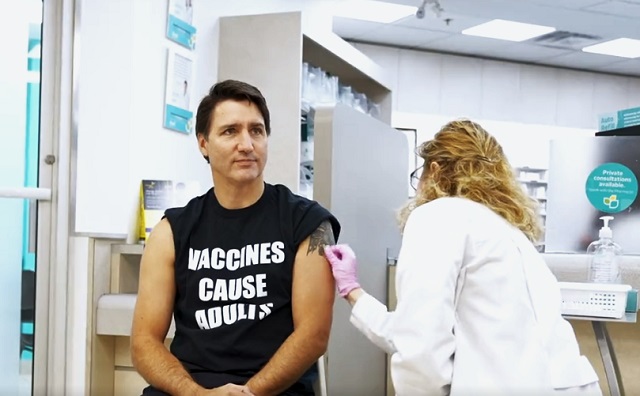Brownstone Institute
The Real Threat of 15-Minute Cities

From the Brownstone Institute
BY
The Guardian’s Oliver Wainwright recently discussed a new “international socialist conspiracy” that has taken the world by storm. “Fringe forces of the far left,” he noted, “are plotting to take away our freedom to be stuck in traffic jams, to crawl along clogged ring roads and trawl the streets in search of a parking spot.” The name of this “chilling global movement?” he asked, sarcastically and somewhat contemptuously: The “15-minute city.” Wainwright believes these cities are simply part of a “mundane planning theory.” He’s wrong.
A few days after Wainwright’s piece was published, three academics called 15-minute cities (FMCs) “the hottest conspiracy theory of 2023.” In a truly elitist manner, they poked fun at those who dared to question the motive behind FMCs.
One needn’t be a card-carrying QAnon member to have fears over these Trojan-like creations. Before going any further, it’s important to get our definitions in order. As the political scientist Kelly M. Greenhill has noted, not all conspiracy theories are wacky, and not all conspiracy theories are wrong. Take the Watergate conspiracy theory, for instance, or the fact that Edith Wilson made most of the executive decisions after her husband, President Woodrow Wilson, suffered a stroke. Quite often conspiracy theories turn out to be accurate.
Also known as smart cities, FMCs are places where everything imaginable, from your place of work to your favorite pizzeria, is accessible either by foot or bike (not by car, though; they will be verboten) in 15 minutes or less. What’s so bad about this?
On first inspection, very little. We are, after all, creatures of comfort. We live in a world where the mantra “Too Long, Didn’t Read (TL;DR)” now reigns supreme. We crave convenience; we crave expediency. However, expediency isn’t always a good thing; sometimes it’s downright dangerous. This is especially true when people, either consciously or otherwise, trade their freedom for ease of access to certain services. FMCs may make it easier for citizens to get from A to B, but these creations will also make it easier for those in power to spy on us, to harvest our data, and enable Big Brother to become Bigger Brother.
As I write this, FMCs are being actively championed by the World Economic Forum (WEF), the group behind the “Great Reset” and the idea of owning nothing, having absolutely no privacy, and being very happy. This fact alone should concern all readers.
Want to discuss the WEF?
To many, I’m sure FMCs sound incredibly cool. But don’t be fooled by the name. FMCs are actually “smart cities.” As I have noted elsewhere, the word “smart” is really just a synonym for surveillance. These ultra-modern, tech-saturated monstrosities use hundreds of thousands of sensors to vacuum up copious amounts of personal data.
FMC policies are currently being rolled out in cities such as Barcelona, Bogotá, Melbourne, Paris, and the dystopian wasteland known as Portland. What do these cities have in common? Surveillance technology. Between now and 2040, cities right across the United States (and beyond) are predicted to spend trillions of dollars on the installation of additional cameras and biometric sensors. Sure, surveillance is bad now. But, as Randy Bachman famously hollered, you ain’t seen nothing yet.
By 2050, more than two-thirds of the world’s population will live in closely surveilled urban centers, like glorified rats in cramped cages. Contrary to popular belief, we no longer live in a panoptic society. When Jeremy Bentham, the English philosopher and social theorist, put forward the idea of this prison system, there was no internet. In truth, there weren’t even cars. We now live in a post-panoptic world—a digital panopticon, if you will—with huge social media platforms collecting personal user data before selling it to the highest bidder.
The companies running these platforms often work closely with government officials, identifying supposed sinners and punishing them in the swiftest of manners. As the writer Kylie Lynch has noted, these companies know absolutely everything about you; they have instant access to your browser history, your activity online, and now, rather worryingly, even your biometrics. Not surprisingly, these Big Tech companies will have a big impact on the FMCs of the future, by providing the underlying digital infrastructure needed to monitor us and ensure mass compliance.
FMC are wolves in sheep’s clothing. Don’t believe the countless stories telling you otherwise. It has become common for elitist, mainstream outlets to poke fun at those who dare to question the “we have your best interests at heart” narratives. We have been burned too many times before.
Republished from Epoch
Brownstone Institute
Deborah Birx Gets Her Close-Up

From the Brownstone Institute
BY
According to Birx, she intentionally buried the more draconian elements of the lockdowns in text at the end of long documents, theorizing (correctly apparently) that most reporters or readers would just “skim” the document and would not focus on how extreme and unprecedented these mandates actually were.
Most Americans will remember Dr. Deborah Birx as the “scarf lady” who served on the White House’s Covid Response Team beginning in February 2020.
According to a recently-released (but little-seen) 24-minute mini-documentary, it was Birx – even more so than Anthony Fauci – who was responsible for government “guidelines,” almost all of which proved to be unnecessary and disastrous for the country.
According to the documentary, the guidelines ran counter to President Trump’s initial comments on Covid, but ultimately “toppled the White House (and Trump) without a shot being fired.”
The mini-documentary (“It Wasn’t Fauci: How the Deep State Really Played Trump”) was produced by Good Kid Productions. Not surprisingly, the scathing 24-minute video has received relatively few views on YouTube (only 46,500 since it was published 40 days ago on Feb. 26).
I learned of the documentary from a colleague at Brownstone Institute, who added his opinion that “Birx (is) far more culpable than Fauci in the Covid disaster…Well worth the time to see the damage an utter non-scientist, CIA-connected, bureaucrat can do to make sure things are maximally bad.”
I agree; the significant role played by Birx in the catastrophic national response to Covid has not received nearly enough attention.
Brought in from out of Nowhere…
From the video presentation, viewers learn that Birx was added to the White House’s Coronavirus Task Force as its coordinator in latter February 2020.
Birx worked closely with Task Force chairman Vice President Mike Pence, a man one suspects will not be treated well by future historians.
According to the documentary, “career bureaucrats” like Birx somehow seized control of the executive branch of government and were able to issue orders to mayors and governors which effectively “shut down the country.”
These bureaucrats were often incompetent in their prior jobs as was Birx, who’d previously served as a scientist (ha!) in the Army before leading the government’s effort to “fight AIDS in Africa” (via the PEPFAR Program).
When Birx was installed as coordinator of Covid Response she simply rehashed her own playbook for fighting AIDS in Africa, say the filmmakers.
The three tenets of this response were:
- “Treat every case of this virus as a killer.”
- “Focus on children,” who, the public was told, were being infected and hospitalized in large numbers and were a main conduit for spreading the virus.
- “Get to zero cases as soon as possible.” (The “Zero Covid” goal).
The documentary primarily uses quotes from Scott Atlas, the White House Task Force’s one skeptic, to show that all three tenets were false.
Argued Atlas: Covid was not a killer – or a genuine mortality risk – to “99.95 percent” of the population. Children had virtually zero risk of death or hospitalization from Covid. And there was no way to get to “zero cases.”
Atlas Didn’t Shrug, but was Ignored…
Furthermore, the documentary convincingly illustrates how the views of Atlas were ignored and how, at some point, his ability to speak to the press was curtailed or eliminated.
For example, when Atlas organized a meeting for President Trump with Covid-response skeptics (including the authors of the Great Barrington Declaration) this meeting was schedule to last only five minutes.
The documentary also presents a report from the inspector general of the Department of State that was highly critical of Birx’s management style with the African “AIDS relief” program she headed.
Among other claims, the report said she was “dictatorial” in her dealings with subordinates and often “issued threats” to those who disagreed with her approach.
Shockingly, this highly-critical report was published just a month before she was appointed medical coordinator of the Coronavirus Task Force.
A particularly distressing sound bite from Birx lets viewers hear her opinion on how controversial “guidance” might be implemented with little pushback.
According to Birx, she intentionally buried the more draconian elements of the lockdowns in text at the end of long documents, theorizing (correctly apparently) that most reporters or readers would just “skim” the document and would not focus on how extreme and unprecedented these mandates actually were.
The documentary points out that Birx’s prescriptions and those of President Trump were often in complete conflict.
Birx, according to the documentary, once pointed this out to Vice President Pence, who told her to keep doing what she believed.
Indeed, the Vice President gave Birx full use of Air Force 2 so she could more easily travel across the country, spreading her lockdown message to governors, mayors, and other influencers.
Several Covid skeptic writers, including Jeffrey Tucker of Brownstone Institute, have noted that President Trump himself went from an opponent of draconian lockdowns to an avid supporter of these responses in a period of just one or two days (the pivotal change happened on or around March 10th, 2020, according to Tucker).
Whoever or whatever caused this change in position, it does not seem to be a coincidence that this about-face happened shortly after Birx – a former military officer – was named to an important position on the Task Force.
(Personally, I don’t give Anthony Fauci a pass as I’ve always figured he’s a “dark master” at manipulating members of the science/medical/government complex to achieve his own desired results.)
This documentary highlights the crucial role played by Deborah Birx and, more generally, how unknown bureaucrats can make decisions that turn the world upside-down.
That is, most Americans probably think presidents are in charge, but, often, they’re really not. These real rulers of society, one suspects, would include members of the so-called Deep State, who have no doubt installed sycophants like Fauci and Birx in positions of power.
I definitely recommend this 24-minute video.
A Sample of Reader Comments…
I also enjoyed the Reader Comments that followed this video. The first comment is from my Brownstone colleague who brought this documentary to my attention:
“… As I said, things can change over the period of 20 years but in the case of Birx/Fauci, I do not believe so. I have never seen people entrenched in the bureaucracy change.”
Other comments from the people who have viewed the mini-documentary on YouTube:
“Pence needs to be held accountable.”
“What does Debbie’s bank account look like?”
“(The) final assessment of President Trump at the 23:30 mark is, while painful, accurate. He got rolled.”
“This is very hard to find on YouTube. You can literally search the title and it doesn’t come up.”
“Excellent summary, hope this goes viral. Lots of lessons to learn for future generations.”
“Eye opening. Great reporting.”
Post from One Month Ago…
“37 likes after 3 years of the most controversial and divisive action in recent history. How can this be?”
“Oh never mind. YouTube hid it from the public for years.”
“Probably hasn’t been taken down yet for that reason, relatively low views.”
“Thanks for this! Sounds like everyone below President Trump was on a power trip and I didn’t think it was possible to despise Pence more than I already do.”
“…the backing of CDC, legacy media, WHO and government schools, business folding in fear are ALL responsible. Accountability for every person and agency is paramount!”
“Should be noted that her work on AIDS in Africa was just as useless and damaging.”
“First, any mature, adult woman who speaks with that much vocal fry should be immediately suspect. And the glee with which she recounts her role at undermining POTUS is remarkable and repulsive. This woman should NEVER be allowed to operate the levers of power again.”
Republished from the author’s Substack
Brownstone Institute
Justices’ Grave Error in Murthy v. Missouri

From the Brownstone Institute
BY
Along with my co-plaintiffs, I was at the Supreme Court last week for oral arguments in our Murthy v. Missouri case, in which we are challenging the federal government’s alleged censorship on social media. The Supreme Court will likely rule in June whether to uphold, modify, or strike down the Fifth Circuit Court of Appeals’ injunction against five federal agencies, in what, the district court judge wrote, “arguably involves the most massive attack against free speech in United States’ history.”
At the hearing, Justice Samuel Alito pointed out that emails between the White House and Facebook “showed constant pestering of Facebook.” He went on to comment, “I cannot imagine federal officials taking this approach to the print media…It’s treating these platforms like subordinates.” He then asked the government’s attorney, “Would you treat the New York Times or the Wall Street Journal this way? Do you think the print media considers themselves ‘partners’ with government? I can’t imagine the federal government doing that to them.”
The government’s attorney had to admit, “The anger is unusual” — referring to White House official Rob Flaherty literally cursing at a Facebook executive and berating him for not taking action quickly enough to comply with the government’s censorship demands.
Justice Brett Kavanaugh followed up, asking, “On the anger point, do you think federal government officials regularly call up journalists and berate them?” It’s worth recalling that Kavanaugh worked as a White House attorney before he was appointed to the court, as did Justices John Roberts and Elena Kagan. No doubt there were times they dialed a journalist or editor to try to convince them to change a story, clarify a factual assertion, or even hold or quash the publication of a piece. Kavanaugh admitted, “It’s not unusual for the government to claim national security or wartime necessity to suppress a story.”
Perhaps colorful language is sometimes used in these conversations, as Kavanaugh himself hinted. Kagan concurred: “Like Justice Kavanaugh, I have had some experience encouraging the press to suppress its own speech…This happens literally thousands of times a day in the federal government.” With a wink to the other former executive branch attorneys on the bench, Roberts quipped, “I have no experience coercing anyone,” which generated a rare chuckle from the bench and audience.
This analogy to government interactions with print media, however, does not hold in the case of the government’s relationship with social media. There are several crucial differences that profoundly change the power dynamic of those interactions in ways directly relevant to our case. These differences facilitate, in Alito’s words, the government treating the platforms like subordinates in ways that would be impossible with print media.
Behind the Scenes
First, when a government official contacts a newspaper, he is talking directly to the journalist or editor — the person whose speech he is trying to alter or curtail. The writer or editor has the freedom to say, “I see your point, so I’ll hold my story for one week to allow the CIA time to get their spies out of Afghanistan.” But the speaker also has the freedom to say, “Nice try, but I’m not persuaded I got the facts wrong on this, so I’m running the story.” The publisher here has the power, and there is little the government can do to threaten that power.
By contrast, with requests or demands for social media censorship, the government was never talking with the person whose speech was censored, but with a third party operating entirely behind the scenes. As my co-plaintiff, the eminent epidemiologist Dr. Martin Kulldorff, quipped, “I would have been happy to get a call from a government official and hear about why I should take down a post or change my views on the scientific evidence.”
Power Dynamic
Additionally, there is little the government can do to destroy the business model and cripple the New York Times or Wall Street Journal, and the journalists and editors know this. If the government pushes too hard, it will also be front page news the next day: “Government Trying to Bully The Post to Censor Our Breaking Story,” with the lede, “Naturally, we told them to go pound sand.”
But the power dynamic is entirely different with Facebook, Google, and X (formerly Twitter): The government does have a sword of Damocles to hang over the head of noncompliant social media companies if they refuse to censor — in fact, several swords, including the threat to remove Section 230 liability protections, which Facebook founder Mark Zuckerberg has accurately called an “existential threat” to their business, or threats to break up their monopolies. As the record in our lawsuit shows, the government explicitly made just such threats, even publicly on several occasions, in direct connection to their censorship demands.
Furthermore, unlike the major tech companies, newspapers or magazines do not have massive government contracts that might disappear if they refuse to comply. When the FBI or Department of Homeland Security calls Facebook or X with censorship demands, the corporate executives know that a weaponized agency has the power to launch frivolous but onerous investigations at any time. It thus becomes virtually impossible for social media companies to tell the government to take a hike — indeed, they may have a fiduciary duty to shareholders not to incur serious risks by resisting government pressure.
The text of the First Amendment doesn’t say the government shall not “prevent” or “forbid” free speech; it says the government shall not “abridge” free speech — i.e., shall not do anything to lesson a citizen’s ability to speak or diminish one’s potential reach. A sensible and clear injunction would simply state, “Government shall not request that social media companies remove or suppress legal speech.”
But if the justices want to distinguish between persuasion and coercion in the injunction, they need to appreciate that social media companies operate in a very different relationship with government than traditional print media. These asymmetrical power dynamics create a relationship ripe for unconstitutional government coercion.
Republished from The Federalist
-

 COVID-195 hours ago
COVID-195 hours agoCDC Quietly Admits to Covid Policy Failures
-

 COVID-198 hours ago
COVID-198 hours agoJapanese study shows disturbing increase in cancer related deaths during the Covid pandemic
-

 Great Reset3 hours ago
Great Reset3 hours agoClimate expert warns against extreme ‘weather porn’ from alarmists pushing ‘draconian’ policies
-

 Alberta2 days ago
Alberta2 days agoDanielle Smith warns arsonists who start wildfires in Alberta that they will be held accountable
-

 National2 days ago
National2 days agoCanada’s Governor General slammed for hosting partisan event promoting Trudeau’s ‘hate speech’ bill
-

 Bruce Dowbiggin1 day ago
Bruce Dowbiggin1 day agoWhy Are Canadian Mayors So Far Left And Out Of Touch?
-

 Economy1 day ago
Economy1 day agoExtreme Weather and Climate Change
-

 International1 day ago
International1 day agoTelegram founder tells Tucker Carlson that US intel agents tried to spy on user messages







